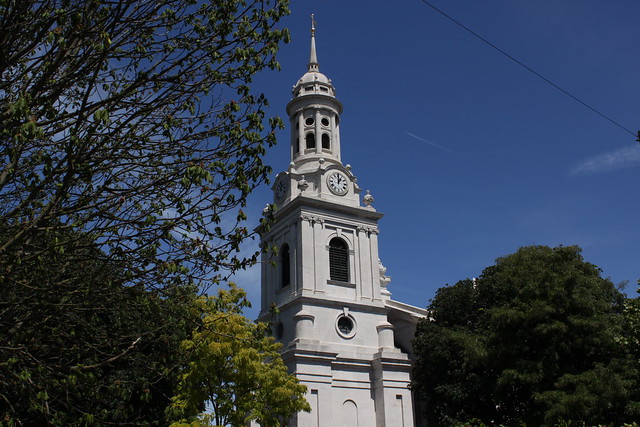The way things have been going lately, you could be forgiven for thinking that Charlton Athletic is all about internal strife, financial gloom and pub rumours. It prides itself on being a family club but it seems, at times, fatally split down the middle. Like many families, come to think about it.
It wasn’t always this way. Not back in 1905, anyway, when a bunch of 16 and 17 year old kids were encouraged by two local youth missions to form a new football club down on Eastmoor Street in an area now dominated by the Thames Barrier. They were singleminded chaps who, without any shilly-shallying, elected to call themselves Charlton Athletic and to play in red shirts This band of brothers clearly started as they meant to go on.
An advertisement in the Kentish Independent, which described their standard as “medium strength” swelled the initital ranks and with support from local publican Harry Wells, the new team opened their account with a 6-1 victory over Sivertown Wesley United on Siemens Meadow in December 1905.
Among the line-up was a husky outside right called William George Bonner, better known to his mates as “Porky”, who went on to make his mark in club history by scoring their first competitive goal in a 6-1 mauling of Nunhead Swift Reserves on September 22nd 1906, by which time the newcomers were members of Lewisham League Division Three.
Porky died in Lee in 1954 but remains connected to the famous club he helped create through successive generations of his family, who continue to hold season tickets at The Valley. West Stand regular Terry Bennett grew up on his colourful grandad’s footballing stories, not to mention his important contribution as a Royal Artillery cook during World War 1. Apparently Porky’s notorious dumplings caused untold havoc when lobbed across No Mans Land into enemy lines. “Probably shortened the war,” recalled their modest creator.
In 1910, the club’s chairmanship was taken over by Arthur “Ikey” Bryan, an enterprising fish ‘n chip entrepreneur reputedly responsible for their mysterious but jealously guarded nickname. Clearly not the full shilling on match days, Ikey took to turning up at games with a haddock pinned to a pole. The story goes that haddock morphed colloquially into ‘addock, then further into ‘addick. It might, on the other hand, be explained by the simple erosion of Athletic but Ikey Bryan’s endearing lunacy has the virtue of uniqueness and meets with almost universal approval. So the Addicks they became and the Addicks they remain.
Porky Bonner had left the playing staff by 1911 when a critical development two miles down river from Eastmoor Street cemented Charlton’s place as the region’s premier football club. They were more than interested spectators as the questionable machinations of Woolwich Arsenal FC chairman Sir Henry Norris moved the powerhouse Arsenal lock, stock and gun barrel across the Thames into the North London bailiwick of Tottenham Hotspur, where they remain to this day as a thorn in Spurs’ side. Norris’ provocative action paled into insignificance alongside the infamous backroom chicanery which promoted Arsenal to the First Division in 1919 at the expense of their outmanouevred new neighbours.
Arsenal’s furtive flit was the making of Charlton, their humble cousins from the next parish. In one fell, if not foul, swoop, the riverside rookies became cocks-of-the-walk in Woolwich, where many of the Royal Arsenal’s betrayed workers switched their allegiance to them. Football hates a vacuum as much as nature and this one was filled with alacrity.
Charlton’s growing reputation persuaded them to embrace professionalism in 1920. A single season spent in the Southern League prefaced their admission to the Football League (South) for the 1921-22 campaign, which they kicked off with a 1-0 win over Exeter City at The Valley on August 27th, with Tommy Dowling scoring the momentous goal. Still on the books since 1905 was sole survivor Albert “Mosky” Mills, who made two league appearances during the groundbreaking 1921-22 season.
Two years after entering the Football League, the Addicks embarked on a giant-killing Cup run, which still defies belief. This fledgling Third Division team, still wet behind their professional ears, won through two preliminary rounds before knocking out, in succession, vaunted First Division opposition in Manchester City (2-1), Preston North End (2-0) and West Bromwich Albion (1-0) to earn their place in the quarter-finals against Cup legends Bolton Wanderers. On March 10th, 1923, they succumbed 1-0 to a David Jack goal before 41,023 sardine-packed Valley onlookers as the Trotters proceeded to the first Wembley Cup Final, where they beat West Ham 2-0 in the chaotic White Horse Final. Don’t expect to hear their wonderful feat mentioned whenever Cup giant-killers are feted. That kind of attention is normally paid to minnows who manage just one historic result. Charlton knocked over three Goliaths. Then lost 1-0 to the eventual Cup winners. Hardly worth making a fuss about.
Continuing in the Third Division, Charlton were promoted as champions to the Second Division in 1928-29 and survived there until their bottom placed finish in 1932-33 saw them relegated. During that catastrophic campaign, manager Alex McFarland was sacked in December 1932, with former goalkeeper Albert Lindon filling in until, in May 1933, Jimmy Seed took over the helm. Part one of Charlton’s incredible history was complete.
The arrival of the astute Seed, himself a decorated player with Spurs, Sheffield Wednesday and England, kickstarted Part Two – a meteoric three-year rise into English football’s elite, where they remained from 1936 until 1957, appeared in two post-war Cup finals, took part in the most amazing football game ever played, then went on to distinguish themselves in the financial jungle that is the Premier League. But that’s another story for another day.
To be continued…

































